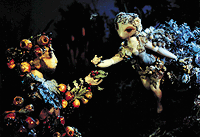|
|
ANIMATION WORLD MAGAZINE - ISSUE 5.04 - JULY 2000
Jiri Trnka -- Walt Disney Of The East!by Edgar Dutka
"Jiri Trnka -- Walt Disney Of The East!" This was the heading of an article written by an English journalist after he saw Trnka's wide screen puppet feature film The Midsummer Night's Dreamat the Cannes Film Festival in 1959. He exaggerated in many ways, as there were many differences between the two great artists. The least of which is that Disney focused his work on the children or family audience, while Trnka addressed most of his films to the adult audience. He arrived to the first post-war Cannes Festival in 1946 with his three cartoons (his filmmaking career had only begun on May 29, 1945, when a group of young animators asked the famous book illustrator to become their boss!) Despite the fact that his fairytale cartoon The Robbers and the Animalswon the festival, another film that was entered, The Present,was of more importance to Trnka's work. The Present(written by J. Brdecka) was a cartoon for adults -- a satire with Trnka's very own individual art design and a non-Disney way of storytelling. This film was completely misunderstood until Stephen Bosustow congratulated Trnka on it three years later. If you compare The Presentwith UPA's productions you know why! It was a visible step that divided post-war animation into two groups: the productions of big studios (classics) and films that were modern expressions, created in form and content by strong, individual personalities.
But Trnka loved puppets and he preferred puppets to all other kinds of art. That is why he, along with his fellow animators wanted to try "to make puppets move on the screen" and established a small studio of puppet films (called The Studio of Jiri Trnka today) in 1946. From this very year on, Trnka created one puppet feature film each year (The Czech Year, The Ceasar's Nightingale, The Novel with a Basefrom Chekhov's work, a Western parody The Aria of Prairieand Bajaja). The Czech Yearis a very significant work for Trnka's career. (The film's Czech title is Spalicek,which refers to illustrated folk songbooks and also a piece of wood.) When he was asked twenty years later, which of his films he prefered most, he remembered The Czech Year.It was not his patriotism at all. The film is a cycle of six parts illustrating the old Czech folk customs around the year. It was prior to Christmas 1946, so Trnka decided to start with The Bethlehemsequence, which was inspired by his own painting. The short film was very successful and he got the idea to go on - the cycle finally reaching six parts. The Czech Year,his first puppet feature film, was internationally acclaimed for his beautiful, brilliant animation of simple puppets (pieces of wood) and music inspired by Czech folk songs (V. Trojan).
Starting in February of 1948, even the Communists enjoyed his work and subsidized all of his following films. It seemed to them that puppets were for children, and that they could not cause any political harm; however, until the late '80s two parts of the film Spring,with a procession of Christians, and The Legend of St. Prokopwere banned as church propaganda. When Trnka finished the national fairytale Bajajain 1950 he was greatly honoured by the regime. But when he wanted to adapt Don Quijotein 1951, his project was banned by the Government as too cosmopolitan. There always existed two sides to the Government's "generous" hand. Instead of Don Quijote,he was pressed to create historic myths in The Old Czech Legends(1952). Trnka didn't want to. He'd rather have quit working at the studio and gone back to illustrating children's book, but in solitude he found the clue to this theme. There are strong and brilliant scenes in the film, great character animation and superb music, more in the way of Janacek than Smetana. Trnka became a real filmmaker with this film but he was right: such a theme had a very limited audience. Even Czechs did not appreciate a filmed version of the history that they had to learn at school.
|
||||||
| 1 | 2 |
Note: Readers may contact any Animation World Magazine contributor by sending an e-mail to editor@awn.com.


